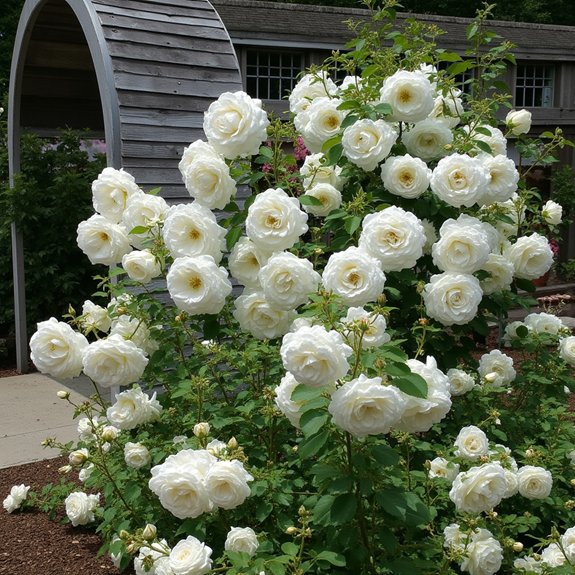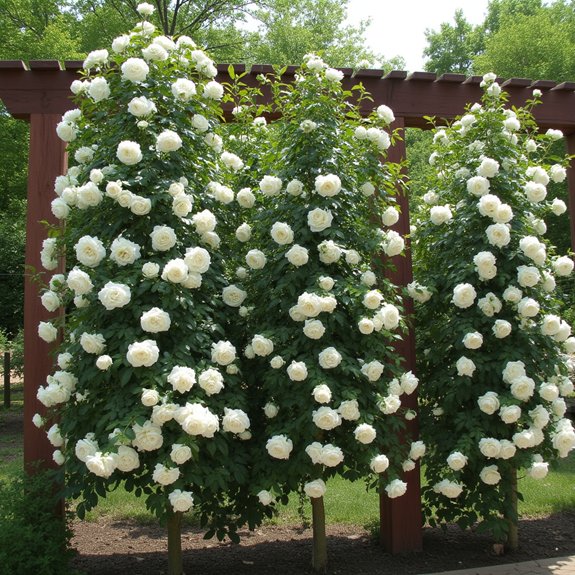You’ll find that white roses comprise nearly 30% of all rose varieties available today, making them surprisingly abundant in the gardening world. These elegant blooms aren’t just beautiful—they’re also among the most versatile plants you can add to your landscape. Whether you’re working with a tiny balcony or sprawling garden beds, there’s a white rose that’ll transform your space. But choosing the right variety depends on factors you might not have considered yet.
Contents
- 1 Top White Rose Cultivars for Every Garden
- 2 Essential Growing Requirements and Sun Exposure
- 3 Height Variations From Ground Cover to Climbing Varieties
- 4 Hardiness Zones and Climate Considerations
- 5 Planting and Soil Preparation Guidelines
- 6 Maintenance and Seasonal Care Practices
- 7 Design Applications for Landscape Enhancement
- 8 Fragrance Profiles and Aesthetic Appeal
Top White Rose Cultivars for Every Garden

When you’re planning a white rose garden, selecting the right cultivars makes all the difference between a stunning display and a disappointing mess. Consider your space first—compact gardens benefit from Flower Carpet White at 1-2.5 feet, while larger areas can accommodate Snow Goose reaching 8-10 feet. Rose symbolism traditionally represents purity and new beginnings, making white varieties perfect for wedding gardens or memorial spaces. For enhanced garden aesthetics, mix heights strategically: place Desdemona (3-4 feet) in front of Sally Holmes (6-12 feet). Most varieties thrive in zones 5-10, requiring full sun and well-draining soil for ideal performance.
Essential Growing Requirements and Sun Exposure
Most white roses demand full sun exposure, meaning six to eight hours of direct sunlight daily for peak performance. This sunlight efficiency directly impacts bloom production, disease resistance, and overall plant vigor. Varieties like Snow Goose and Sally Holmes won’t tolerate shade well, while Flower Carpet White and Alba Maxima adapt to part-shade conditions.
Understanding growth patterns helps you plan accordingly. Compact varieties like White Drift reach 1-1.5 feet, perfect for borders. Climbers like Sally Holmes stretch 6-12 feet, requiring sturdy support structures. Full sun varieties typically bloom more frequently, produce stronger stems, and develop better fragrance than shade-grown counterparts.
Height Variations From Ground Cover to Climbing Varieties

White roses span an impressive height range, from petite 12-inch ground covers to towering 15-foot climbers that’ll transform your garden’s vertical space. Ground cover varieties like White Drift reach just 1-1.5 feet, perfect for borders and mass plantings. Mid-sized rose types including Desdemona grow 3-4 feet, ideal for garden beds and focal points. You’ll find climbing varieties like Sally Holmes stretching 6-12 feet, while Iceberg can reach an impressive 15 feet with proper support. These height variations let you create layered garden designs, from low carpets to dramatic vertical displays that maximize your growing space efficiently.
Hardiness Zones and Climate Considerations
Understanding hardiness zones helps you choose white roses that’ll thrive in your specific climate conditions. Most white varieties flourish in zones 5-10, though some extend into zone 4 or 11. Alba Maxima offers exceptional zone compatibility, surviving zones 4-11 with proper care.
Climate adaptability varies considerably between cultivars. Flower Carpet White handles zones 5-9, while Snow Goose extends to zone 11. Consider your area’s winter lows and summer highs when selecting varieties.
Choose hardier options like White Drift (zones 4-11) for colder regions. Warmer climates benefit from heat-tolerant varieties with extended growing seasons.
Planting and Soil Preparation Guidelines

Although white roses appear delicate, they’ll reward you with stunning blooms when planted in properly prepared soil. Start by choosing a location with at least six hours of daily sunlight, then dig a hole twice the width of your root ball.
Proper soil drainage prevents root rot, so amend heavy clay with compost or sand. The correct planting depth matters—position the graft union at soil level in warm climates, slightly below in cold zones.
Mix organic matter into existing soil, water thoroughly after planting, and apply two-inch mulch layer around the base.
Maintenance and Seasonal Care Practices
Successful rose gardening doesn’t end at planting—your white roses need consistent care throughout the year to maintain their health and beauty. Establish a watering schedule that delivers 1-2 inches weekly, focusing water at the base to keep foliage dry. During spring, apply balanced fertilizer and fresh mulch around plants.
Summer maintenance includes deadheading spent blooms and monitoring for black spot or aphids. Effective pest management involves weekly inspections and prompt treatment when issues arise. Fall preparation means reducing watering frequency and applying protective mulch in zones 5-6. Winter requires minimal intervention except removing damaged canes.
Design Applications for Landscape Enhancement
When you’re planning garden layouts, white roses serve as versatile anchor points that brighten dark corners and create stunning focal areas. You’ll find compact varieties like White Drift (1′-1.5′) perfect for edging pathways, while towering Sally Holmes (6′-12′) creates dramatic backdrops. For effective landscape design, plant Iceberg roses in groups of three to five for maximum visual impact. Consider garden aesthetics by pairing white blooms with purple lavender or deep green boxwood hedges. Climbing varieties like Snow Goose transform bare walls into living art, reaching 8′-10′ heights to soften harsh architectural lines beautifully.
Fragrance Profiles and Aesthetic Appeal
While visual beauty draws you to white roses initially, their fragrance profiles create the lasting emotional connection that transforms gardens into sensory experiences. Fragrance intensity varies dramatically between varieties, with Alba Maxima offering powerful, traditional rose scent, while Iceberg provides subtle, sweet notes.
You’ll find aesthetic combinations work best when pairing fragrant varieties near seating areas or walkways. Sally Holmes delivers moderate fragrance with stunning visual impact, reaching 6-12 feet tall. Pope John Paul II combines classic rose scent with elegant form, perfect for cutting gardens where you can enjoy both fragrance and beauty indoors.
